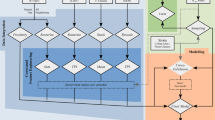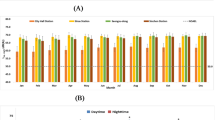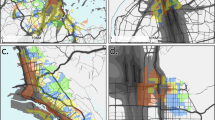Abstract
Background
Community noise pollution can adversely impact health, yet noise has rarely been systematically measured in United States (U.S.) cities for epidemiological research.
Objective
Collaborating with the Multnomah County Health Department, we developed an exploratory measurement campaign to systematically capture community noise in Portland, Oregon, U.S. to inform environmental health research and practice.
Methods
We identified short-term measurement locations using weighted probability sampling and developed a protocol for deploying Class 1 sound level meters at identified sites to measure sound levels continuously for at least five days. We calculated daytime, nighttime, and daily-average noise metrics including day-night average sound levels (DNL), day-evening-night levels (Lden), intermittency ratios (IR), and 10th- and 90th-percentile noise levels (L90, L10). We evaluated noise metrics by built environment and sociodemographic characteristics at the census tract level and performed machine learning-based cluster analysis to identify locations with similar exposure profiles. Nine additional locations were sampled continuously for one year to assess agreement between short- and long-term noise measurements.
Results
DNL ranged from 49.6 to 86.7 decibels across short-term sites (n = 217). DNL exceeded U.S. Environmental Protection Agency guidelines at 78% of sites, and nighttime noise exceeded World Health Organization guidelines at 90%. Short-term sites in census tracts with higher median income and proportion of white population had lower DNL compared to lower median income and proportion of white population census tracts. Cluster analysis revealed four noise profiles: low LAeq/moderate IR sites usually occurring in residential neighborhoods, high LAeq/moderate IR sites adjacent to major roads, moderate LAeq/high IR sites within 1–2 city blocks of major roads, and high LAeq/low IR and low LAeq/low IR sites near highways or parks, respectively.
impact
-
This study reveals a high prevalence of potentially harmful community noise exposure levels in a medium-large city in the United States, particularly in lower-income and racially diverse neighborhoods. By identifying groupings of sites with similar noise exposure profiles, we establish a foundation for exploring built environment drivers of noise and differential health impacts of multidimensional noise exposures. The measurement protocol and database of noise measurements collected provides tools for researchers and communities (available upon request) to investigate noise exposure patterns, environmental justice concerns, and associated health impacts, with further applications for predictive modeling to estimate individual-level exposures in epidemiologic studies.
This is a preview of subscription content, access via your institution
Access options
Subscribe to this journal
Receive 6 print issues and online access
$259.00 per year
only $43.17 per issue
Buy this article
- Purchase on SpringerLink
- Instant access to full article PDF
Prices may be subject to local taxes which are calculated during checkout





Similar content being viewed by others
Data availability
The datasets generated during and/or analyzed during the current study are available from the corresponding author on reasonable request.
References
King G, Roland-Mieszkowski M, Jason T, Rainham DG. Noise levels associated with urban land use. J Urban Health. 2012;89:1017–30.
Méline J, Van Hulst A, Thomas F, Karusisi N, Chaix B. Transportation noise and annoyance related to road traffic in the French RECORD study. Int J Health Geogr. 2013;12:44.
Fink D. A new definition of noise: noise is unwanted and/or harmful sound. Noise is the new ‘secondhand smoke’. Proc Meet Acoust. 2020;39:050002.
Bozigar M, Huang T, Redline S, Hart JE, Grady ST, Nguyen DD, et al. Associations between aircraft noise exposure and self-reported sleep duration and quality in the United States-based prospective nurses’ health study cohort. Environ Health Perspect. 2023;131:47010.
Clark C, Paunovic K. WHO environmental noise guidelines for the European region: a systematic review on environmental noise and quality of life, wellbeing and mental health. Int J Environ Res Public Health. 2018;15:2400.
Erickson LC, Newman RS. Influences of background noise on infants and children. Curr Dir Psychol Sci. 2017;26:451–7.
Hygge S, Evans GW, Bullinger M. A prospective study of some effects of aircraft noise on cognitive performance in schoolchildren. Psychol Sci. 2002;13:469–74.
Sørensen M, Andersen ZJ, Nordsborg RB, Jensen SS, Lillelund KG, Beelen R, et al. Road traffic noise and incident myocardial infarction: a prospective cohort study. PLoS One. 2012;7:e39283.
van Kempen E, Babisch W. The quantitative relationship between road traffic noise and hypertension: a meta-analysis. J Hypertens. 2012;30:1075–86.
Radun J, Maula H, Rajala V, Scheinin M, Hongisto V. Acute stress effects of impulsive noise during mental work. J Environ Psychol. 2022;81:101819.
Rajala V, Hongisto V. Annoyance penalty of impulsive noise – the effect of impulse onset. Build Environ. 2020;168:106539.
Wunderli JM, Pieren R, Habermacher M, Vienneau D, Cajochen C, Probst-Hensch N, et al. Intermittency ratio: A metric reflecting short-term temporal variations of transportation noise exposure. J Expo Sci Environ Epidemiol. 2016;26:575–85.
Roscoe C, Grady ST, Hart JE, Iyer HS, Manson JE, Rexrode KM, et al. Association between noise and cardiovascular disease in a nationwide U.S. prospective cohort study of women followed from 1988 to 2018. Environ Health Perspect. 2023;131:127005.
Vienneau D, Wunderli JM. Invited perspective: cutting through the noise-the national park service anthropogenic noise model for exposure assessment. Environ Health Perspect. 2023;131:121304.
Allen RW, Davies H, Cohen MA, Mallach G, Kaufman JD, Adar SD. The spatial relationship between traffic-generated air pollution and noise in 2 US cities. Environ Res. 2009;109:334–42.
Huang Y-K, Mitchell UA, Conroy LM, Jones RM. Community daytime noise pollution and socioeconomic differences in Chicago, IL. PLoS One. 2021;16:e0254762.
Mennitt DJ, Fristrup KM. Influential factors and spatiotemporal patterns of environmental sound levels in the contiguous United States. Noise Control Eng J. 2016;64:342–53.
Mydlarz C, Sharma M, Lockerman Y, Steers B, Silva C, Bello JP. The life of a New York City noise sensor network. Sensors. 2019;19:1415.
U.S. Department of Transportation, Federal Highway Administration. Traffic Noise Model (TNM) version 3.2. 2024. https://www.fhwa.dot.gov/environment/noise/traffic_noise_model/ (accessed 29 Sep 2024).
Walker ED, Hart JE, Koutrakis P, Cavallari JM, VoPham T, Luna M, et al. Spatial and temporal determinants of A-weighted and frequency specific sound levels-An elastic net approach. Environ Res. 2017;159:491–9.
Münzel T, Kröller-Schön S, Oelze M, Gori T, Schmidt FP, Steven S, et al. Adverse cardiovascular effects of traffic noise with a focus on nighttime noise and the new WHO noise guidelines. Annu Rev Public Health. 2020;41:309–28.
Van Renterghem T, Botteldooren D. The importance of roof shape for road traffic noise shielding in the urban environment. J Sound Vib. 2010;329:1422–34.
Massey DS. American apartheid: segregation and the making of the underclass. Am J Socio. 1990;96:329–57.
Hughes, Jena. Historical Context of Racist Planning. City of Portland Bureau of Planning and Sustainability. 2019. https://www.portland.gov/bps/documents/historical-context-racist-planning/download (accessed 10 Sep 2024).
McKenzie BS. Neighborhood access to transit by race, ethnicity, and poverty in Portland, OR. City Community. 2013;12:134–55.
Casey JA, Morello-Frosch R, Mennitt DJ, Fristrup K, Ogburn EL, James P. Race/ethnicity, socioeconomic status, residential segregation, and spatial variation in noise exposure in the contiguous United States. Environ Health Perspect. 2017;125:077017.
U.S. Census Bureau. City and town population totals: 2020–2023. 2024. https://www.census.gov/data/tables/time-series/demo/popest/2020s-total-cities-and-towns.html (accessed 21 Apr 2024).
U.S. Census Bureau. Urban and rural. 2023. https://www.census.gov/programs-surveys/geography/guidance/geo-areas/urban-rural.html (accessed 21 Apr 2024).
Bureau of Labor Statistics. American Time Use Survey - 2022 Results. U.S. Department of Labor; 2024, https://www.bls.gov/news.release/archives/atus_06222023.pdf.
City of Portland Bureau of Planning and Sustainability. City of Portland Zoning. PortlandMaps - Open Data. 2023. https://gis-pdx.opendata.arcgis.com/datasets/PDX::zoning/about (accessed 10 Sep 2024).
U.S. Census Bureau. TIGER/Line Shapefile, 2019, state, Oregon, Primary and Secondary Roads State-based Shapefile. 2021. https://catalog.data.gov/dataset/tiger-line-shapefile-2019-state-oregon-primary-and-secondary-roads-state-based-shapefile (accessed 21 Apr 2024).
Bureau of Transportation Statistics. National Transportation Noise Map. 2022. https://www.bts.gov/geospatial/national-transportation-noise-map.
Kanaroglou PS, Jerrett M, Morrison J, Beckerman B, Arain MA, Gilbert NL, et al. Establishing an air pollution monitoring network for intra-urban population exposure assessment: a location-allocation approach. Atmos Environ. 2005;39:2399–409.
What is DNL and why does the FAA use it? | Federal Aviation Administration. 2024. https://www.faa.gov/faq/what-dnl-and-why-does-faa-use-it (accessed 31 Oct 2024).
European Environmental Agency. Lden. European Environment Agency. 2001. https://www.eea.europa.eu/help/glossary/eea-glossary/lden (accessed 10 Sep 2024).
Arora P, Deepali, Varshney S. Analysis of K-means and K-medoids algorithm for big data. Proc Comput Sci. 2016;78:507–12.
Tibshirani R, Walther G, Hastie T. Estimating the number of clusters in a data set via the gap statistic. J R Stat Soc Ser B Stat Methodol. 2001;63:411–23.
Rindfleisch T. A comparative evaluation of two sound level meters. 2018. https://doi.org/10.13140/RG.2.2.26395.31520.
United States Environmental Protection Agency. Information On Levels of Environmental Noise Requisite to Protect Public Health and Welfare With An Adequate Margin of Safety. U.S. Environmental Protection Agency: Office of Noise Abatement and Control, 1974 https://sj-admin.s3-us-west-2.amazonaws.com/1974_0300_USEPA_Noise.pdf (accessed 10 Sep 2024).
World Health Organization. Compendium of WHO and other UN guidance on health and environment: Chapter 11. World Health Organization; 2021. https://cdn.who.int/media/docs/default-source/who-compendium-on-health-and-environment/who_compendium_chapter11_01092021.pdf?sfvrsn=ae302220_5 (accessed 10 Sep 2024).
Basner M, McGuire S. WHO environmental noise guidelines for the European region: a systematic review on environmental noise and effects on sleep. Int J Environ Res Public Health. 2018;15:519.
Rudzik F, Thiesse L, Pieren R, Wunderli JM, Brink M, Foraster M et al. Sleep spindle characteristics and arousability from nighttime transportation noise exposure in healthy young and older individuals. Sleep. 2018;41. https://doi.org/10.1093/sleep/zsy077.
Héritier H, Vienneau D, Foraster M, Eze IC, Schaffner E, Thiesse L, et al. Diurnal variability of transportation noise exposure and cardiovascular mortality: a nationwide cohort study from Switzerland. Int J Hyg Environ Health. 2018;221:556–63.
Clark SN, Alli AS, Nathvani R, Hughes A, Ezzati M, Brauer M, et al. Space-time characterization of community noise and sound sources in Accra, Ghana. Sci Rep. 2021;11:11113.
Can A, Renterghem TV, Rademaker M, Dauwe S, Thomas P, Baets BD, et al. Sampling approaches to predict urban street noise levels using fixed and temporary microphones. J Environ Monit. 2011;13:2710–9.
Gaja E, Gimenez A, Sancho S, Reig A. Sampling techniques for the estimation of the annual equivalent noise level under urban traffic conditions. Appl Acoust. 2003;64:43–53.
Prieto Gajardo C, Barrigón Morillas JM, Rey Gozalo G, Vílchez-Gómez R. Can weekly noise levels of urban road traffic, as predominant noise source, estimate annual ones?. J Acoustical Soc Am. 2016;140:3702–9.
Weuve J, D’Souza J, Beck T, Evans DA, Kaufman JD, Rajan KumarB, et al. Long-term community noise exposure in relation to dementia, cognition, and cognitive decline in older adults. Alzheimers Dement. 2021;17:525–33.
Ragettli MS, Goudreau S, Plante C, Fournier M, Hatzopoulou M, Perron S, et al. Statistical modeling of the spatial variability of environmental noise levels in Montreal, Canada, using noise measurements and land use characteristics. J Expo Sci Environ Epidemiol. 2016;26:597–605.
Brink M, Schäffer B, Vienneau D, Foraster M, Pieren R, Eze IC, et al. A survey on exposure-response relationships for road, rail, and aircraft noise annoyance: differences between continuous and intermittent noise. Environ Int. 2019;125:277–90.
Brink M, Schäffer B, Vienneau D, Pieren R, Foraster M, Eze IC, et al. Self-reported sleep disturbance from road, rail and aircraft noise: exposure-response relationships and effect modifiers in the SiRENE study. Int J Environ Res Public Health. 2019;16:4186.
Brambilla G, Confalonieri C, Benocci R. Application of the intermittency ratio metric for the classification of urban sites based on road traffic noise events. Sensors. 2019;19:5136.
Batterman S, Warner SC, Xia T, Sagovac S, Roberts B, Vial B, et al. A community noise survey in Southwest Detroit and the value of supplemental metrics for truck noise. Environ Res. 2021;197:111064.
Morley DW, Gulliver J. Methods to improve traffic flow and noise exposure estimation on minor roads. Environ Pollut. 2016;216:746–54.
Fallah-Shorshani M, Yin X, McConnell R, Fruin S, Franklin M. Estimating traffic noise over a large urban area: an evaluation of methods. Environ Int. 2022;170:107583.
Aguilera I, Foraster M, Basagaña X, Corradi E, Deltell A, Morelli X, et al. Application of land use regression modelling to assess the spatial distribution of road traffic noise in three European cities. J Expo Sci Environ Epidemiol. 2015;25:97–105.
Clark SN, Alli AS, Ezzati M, Brauer M, Toledano MB, Nimo J, et al. Spatial modelling and inequalities of environmental noise in Accra, Ghana. Environ Res. 2022;214:113932.
Miranda ML, Edwards SE, Keating MH, Paul CJ. Making the environmental justice grade: the relative burden of air pollution exposure in the United States. Int J Environ Res Public Health. 2011;8:1755–71.
Mohai P, Pellow D, Roberts JT. Environmental justice. Annu Rev Environ Resour. 2009;34:405–30.
Dale LM, Goudreau S, Perron S, Ragettli MS, Hatzopoulou M, Smargiassi A. Socioeconomic status and environmental noise exposure in Montreal, Canada. BMC Public Health. 2015;15:205.
Jackson CL, Redline S, Emmons KM. Sleep as a potential fundamental contributor to disparities in cardiovascular health. Annu Rev Public Health. 2015;36:417–40.
Fallah-Shorshani M, Fruin S, Yin X, McConnell R, Franklin M. Estimating near-roadway air pollution from multi-frequency noise measurements. Sci Total Environ. 2024;944:173900.
Montes González D, Barrigón Morillas JM, Rey Gozalo G, Godinho L. Evaluation of exposure to road traffic noise: effects of microphone height and urban configuration. Environ Res. 2020;191:110055.
Locher B, Piquerez A, Habermacher M, Ragettli M, Röösli M, Brink M, et al. Differences between outdoor and indoor sound levels for open, tilted, and closed windows. Int J Environ Res Public Health. 2018;15:149.
Acknowledgements
The authors gratefully acknowledge the contributions of those who made this study possible, including Max Nonnamaker, Dan Trifone, and Abe Moland from the Multnomah County Health Department, Sophie Son and Michael Barzach from the Volpe National Transportation Systems Center, Bruno Paillard from Convergence Instruments, Summya Khatoon from Boston University, and those who volunteered their homes as measurement sites for the SLM comparisons and long-term measurement sites.
Funding
Funding for this work was supported by Multnomah County Intergovernmental Agreement Contract number HD-IGA-E-15536-2023.
Author information
Authors and Affiliations
Contributions
Carson Mowrer: Data Curation, Formal Analysis, Investigation, Methodology, Project Administration, Software, Visualization, Writing – Original Draft Preparation. Andrew Larkin: Writing – Review & Editing. Charlotte Roscoe: Writing – Review & Editing. Stephanie T. Grady: Investigation, Writing – Review & Editing. Junenette L. Peters: Supervision, Investigation, Writing – Review & Editing. Brendon Haggerty: Conceptualization, Resources, Writing – Review & Editing. Perry Hystad: Supervision, Writing – Review & Editing. Matthew Bozigar: Conceptualization, Funding Acquisition, Investigation, Methodology, Project Administration, Resources, Supervision, Writing – Review & Editing.
Corresponding authors
Ethics declarations
Competing interests
The authors declare no competing interests.
Ethical approval
All procedures were performed in compliance with relevant laws and institutional guidelines and have been approved by the Oregon State University Institutional Review Board as not human subjects research (Approval Number HE-2023-497, August 1, 2023).
Additional information
Publisher’s note Springer Nature remains neutral with regard to jurisdictional claims in published maps and institutional affiliations.
Supplementary information
Rights and permissions
Springer Nature or its licensor (e.g. a society or other partner) holds exclusive rights to this article under a publishing agreement with the author(s) or other rightsholder(s); author self-archiving of the accepted manuscript version of this article is solely governed by the terms of such publishing agreement and applicable law.
About this article
Cite this article
Mowrer, C., Larkin, A., Roscoe, C. et al. Systematic measurement and machine learning-based profile characterization of community noise in a medium-large city in the United States. J Expo Sci Environ Epidemiol (2025). https://doi.org/10.1038/s41370-025-00794-y
Received:
Revised:
Accepted:
Published:
DOI: https://doi.org/10.1038/s41370-025-00794-y



